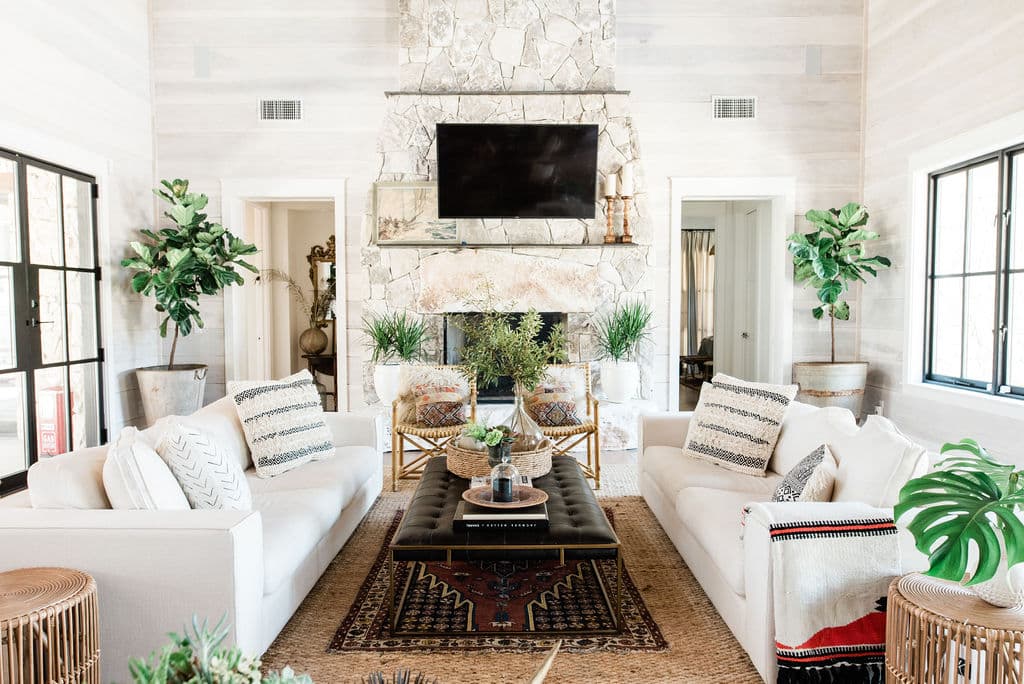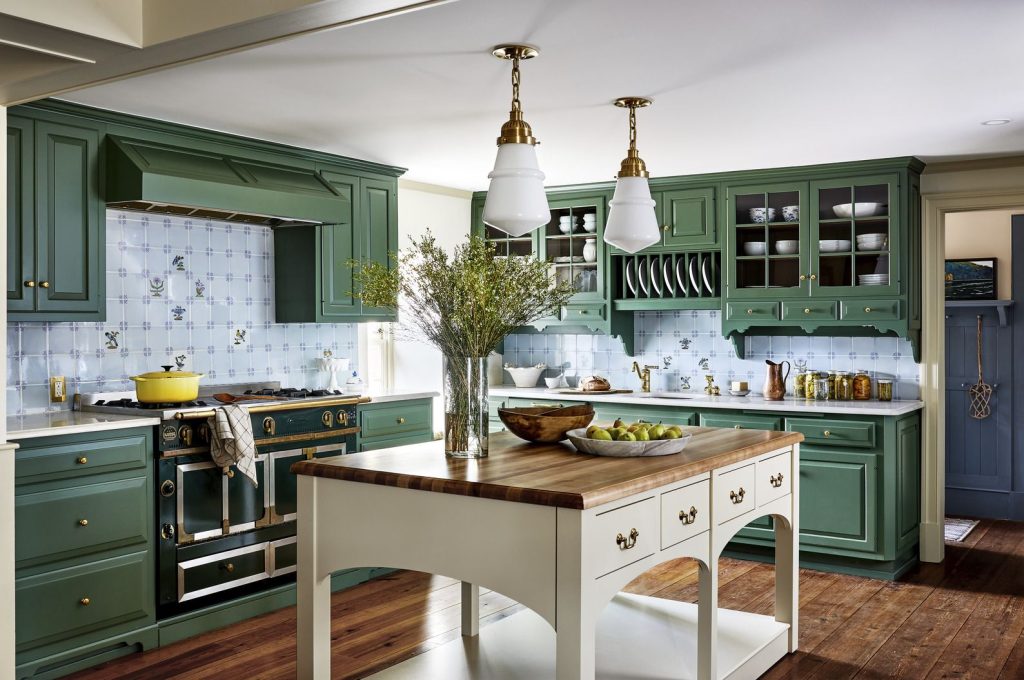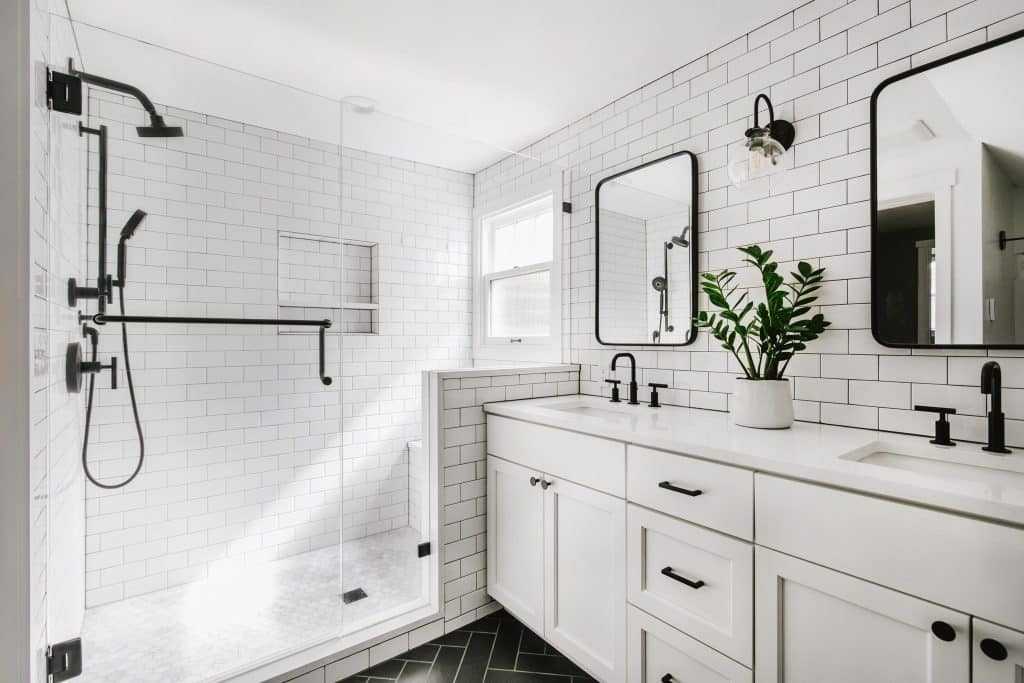The allure of a farmhouse aesthetic lies in its timeless appeal, seamlessly blending rustic charm with modern comforts. Transforming your living space into a cozy, inviting haven with a farmhouse interior design involves a delicate balance of natural elements, muted colors, and a fusion of vintage and contemporary styles.
Here are six tips to help you create a welcoming farmhouse look that exudes comfort and character.
Table of contents
What is Farmhouse Interior Design?
Farmhouse interior design is a style that draws inspiration from the traditional, practical, and charming aesthetic of rural farmhouses. Rooted in simplicity and functionality, farmhouse design combines rustic elements with modern comforts to create a warm and inviting atmosphere.
This style has gained widespread popularity for its timeless appeal and ability to infuse homes with a sense of comfort and character. Whether in a rural setting or an urban dwelling, farmhouse design offers a versatile and enduring approach to creating a cozy and charming home.
Key features of farmhouse interior design include
- Natural Materials
- Neutral Color Palette
- Mix of Vintage and Modern Elements
- Rustic Textures
- Farmhouse-Inspired Decor
- Personalized Touches
- Functional Furniture
- Natural Light
- Greenery and Florals
6 Tips for Creating a Farmhouse Look
#1. Embrace the Warmth of Natural Materials
The heartbeat of a farmhouse style resonates with the use of natural materials. Wooden accents, stone features, and metal touches contribute to the authenticity of a farmhouse look.
Consider incorporating reclaimed wood furniture, exposed beams, or stone surfaces to infuse your space with the warmth and character of nature. The tactile experience of these materials enhances the overall charm of your farmhouse-inspired home.
#2. Paint with a Soothing Palette
The foundation of a farmhouse aesthetic is built upon a soothing, neutral color palette. Opt for soft whites, creams, subtle grays, and earthy tones to create a serene backdrop.
These calming hues provide a canvas for other design elements to shine. Infuse a touch of personality with subtle pops of color through accessories like throw pillows, blankets, or vintage trinkets.
This balance ensures that your farmhouse look is both calming and visually intriguing.
#3. Master the Art of Vintage-Meets-Modern Fusion
A farmhouse look thrives on the seamless integration of vintage and modern elements. Strike a balance by combining antique treasures with contemporary comforts.
Pair weathered farmhouse tables with modern sofas, or juxtapose vintage signs with sleek lighting fixtures. This harmonious blending of eras contributes to the eclectic charm that defines the farmhouse style.
#4. Texture is Key
To create a cozy and inviting atmosphere, texture plays a pivotal role. Introduce rustic textures through fabrics like linen, burlap, and cotton. Use these materials for curtains, upholstery, and throw blankets to enhance the tactile experience of your space.
Experiment with distressed wood, wrought iron, or jute rugs to add layers of visual interest and warmth. The interplay of textures is what makes a farmhouse interior so inviting and comfortable.
#5. Infuse Farmhouse Flair with Thoughtful Decor
Elevate your farmhouse ambiance by incorporating decor inspired by rural living. Mason jar lighting fixtures, barn doors, and open shelving with practical items contribute to the farmhouse charm.
Integrate vintage kitchenware, galvanized metal accents, and woven baskets for a touch of nostalgia. These thoughtful additions bring authenticity to your decor, making your space feel like a true farmhouse retreat.
#6. Personalize with Found Treasures
Make your farmhouse-inspired haven uniquely yours by incorporating found treasures and engaging in DIY projects. Explore local flea markets, antique shops, or thrift stores for one-of-a-kind pieces that tell a story.
Whether it’s repurposing a vintage ladder as a blanket rack or showcasing handmade crafts, infusing personal touches adds an individualistic charm to your farmhouse decor.
Read: 10 Simple Ways to Cool Your Roof in Less Time
What Do I Need to Achieve a Farmhouse Look for my Living Room?
Achieving a farmhouse look for your living room involves a combination of design elements that evoke a cozy, rustic, and timeless feel. Here’s a comprehensive guide to help you transform your living space into a charming farmhouse haven:
Natural Materials
- Wood: Incorporate wooden elements such as farmhouse-style coffee tables, side tables, or exposed wooden beams. Reclaimed or distressed wood adds character and warmth.
- Stone: Consider stone accents for your fireplace, mantel, or even as part of the wall decor. It adds a touch of rustic charm to the space.
Neutral Color Palette
- Whites, Creams, and Earth Tones: Choose a soft and neutral color palette for your walls, furniture, and larger decor items. Whites, creams, soft grays, and earthy tones create a serene backdrop.
Mix of Vintage and Modern Furniture
- Vintage Finds: Integrate antique or vintage furniture pieces, such as a distressed farmhouse dining table, an old wooden chest, or vintage chairs.
- Modern Comforts: Balance the vintage with modern comfort by incorporating plush sofas and contemporary seating options.
Rustic Textures
- Fabric Choices: Opt for fabrics like linen, burlap, and cotton for upholstery, curtains, and throw pillows. These textures add a tactile and cozy dimension to the room.
- Rugs: Consider adding jute or woven rugs for an extra layer of rustic texture.
Farmhouse-Inspired Decor
- Barn Doors: If feasible, incorporate sliding barn doors as a unique and authentic farmhouse feature.
- Open Shelving: Install open shelves with a mix of practical and decorative items. Display vintage kitchenware, woven baskets, and other farmhouse-inspired decor.
Lighting Fixtures
- Mason Jar Lights: Incorporate lighting fixtures with a farmhouse touch, such as mason jar pendant lights or wrought iron chandeliers.
- Natural Light: Maximize natural light by choosing light and airy window treatments.
Greenery and Floral Accents
- Potted Plants: Introduce greenery with potted plants or fresh flowers. Place them in rustic containers like galvanized metal pots or wooden crates.
Examples of FarmhouseInterior Design
#1. Farmhouse Living Room

The living room in the farmhouse style serves as a comfortable sanctuary, encapsulating the warmth and simplicity associated with rural living. Anchored in the farmhouse interior design ethos, this living area radiates an enduring charm by seamlessly combining natural elements, vintage discoveries, and contemporary conveniences.
#2. Farmhouse Kitchen

A farmhouse kitchen is a delightful fusion of rustic charm and modern functionality, encapsulating the heart of farmhouse interior design. This inviting culinary space draws inspiration from traditional farmhouses, blending practicality with warm aesthetics.
#3. Farmhouse Bedroom

A farmhouse bedroom exudes a cozy, rustic charm that transforms this personal sanctuary into a serene haven.
Drawing inspiration from traditional rural living, a farmhouse bedroom is characterized by a harmonious blend of natural elements, vintage touches, and comfortable simplicity.
#4. Farmhouse Bathroom

The farmhouse aesthetic extends its warm embrace to the most intimate spaces of the home, and the farmhouse bathroom is no exception. Defined by a blend of rustic charm and modern functionality, a farmhouse bathroom offers a serene retreat that exudes simplicity and comfort.
FAQs
Farmhouse interiors often feature lighting fixtures with a rustic touch. Consider options like mason jar pendant lights, wrought iron chandeliers, or lantern-style fixtures.
Common farmhouse furniture includes rustic dining tables, distressed cabinets, farmhouse-style sofas, and wooden chests.
Essential farmhouse color schemes include whites, creams, soft grays, and earthy tones.
Absolutely. The farmhouse style can be adapted to suit modern homes. Incorporate farmhouse elements like reclaimed wood, neutral colors, and vintage-inspired decor alongside modern furniture and amenities.
Conclusion
Creating a cozy and charming farmhouse look is all about embracing simplicity, natural elements, and a blend of old and new. By incorporating these six tips into your interior design, you can transform your home into a welcoming retreat that captures the timeless beauty and warmth of a farmhouse aesthetic.
References
Recommendations
- How to Build Porch Stairs | Simple Beginners Guide
- How to Shave Your Balls: Personal Grooming Expertise
- How Long Do Mice Live: Rodent Life Cycle Understanding
- How Long Does a Soccer Game Last: Sports Duration Understanding
- How to Reset Chromecast: Streaming Device Management
- How to Clean Crocs: Footwear Maintenance Method




